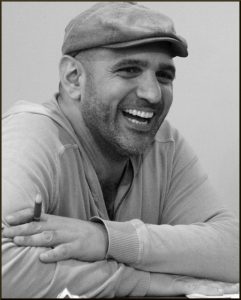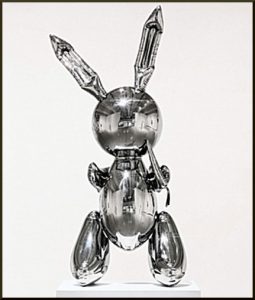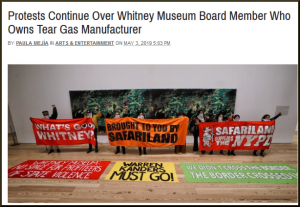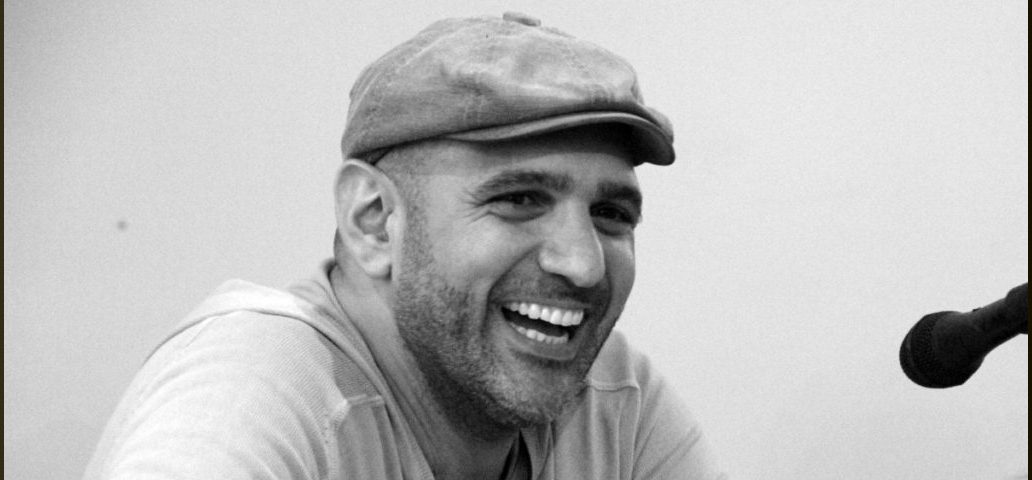CounterSpin interview with Amin Husain on decolonizing museums
by Janine Jackson, published on Fairness and Accuracy in Reporting, May 26, 2019
Janine Jackson: Last month, the American Museum of Natural History decided it would not allow its Hall of Ocean Life to host a gala for fascist Brazilian President Jair Bolsonaro—the institution evidently persuaded that the guy who’s opening new parts of the Amazon to mining, stealing land from indigenous communities he likens to chicken pox and aggressively defunding science was an inappropriate subject for celebration in that particular space.
It didn’t happen out of nowhere. The outcry and its success built on work that’s been going on for years now, calling for accountability from cultural institutions. Our next guest is deeply involved in that work. Amin Husain is an artist and a core organizer with Decolonize This Place. He joins us now by phone from here in town. Welcome to CounterSpin, Amin Husain.
Amin Husain: Thanks for having me.
JJ: Let me ask you, first, a sort of big question. The theater, museums, art galleries—they’re seen in the United States as noblesse oblige, rich people giving back for the public betterment. Is part of the difficulty of demanding some kind of accountability, or even transparency, the way that these institutions are structured from the get-go, and who they see themselves as accountable to?

AH: Yeah, we’ve been looking at these cultural institutions for a while. And they’re not supported publicly in any material way. So then they rely on “one percenters” (if we can just use that language loosely). And I think within that, they end up not hospitable to communities that they claim to serve. But yet they peddle the idea of, “Oh, this is a community space, everyone’s welcome. You are part of the public, the public is who we cater to.”
But, in fact, there’s a whole other economy going on, in which the people with a lot of money, giving money to these cultural institutions, are really determining what aesthetics is, what culture is, what’s worth showing, who does it cater to.
And it ends up excluding most of the people, if we’re going to talk about New York, in the city. Focusing on the American Museum of Natural History, because each museum has a specificity, we call it a “Hall of White Supremacy.”
If you’ve visited the American Museum of Natural History, that gets a lot of public funding, you realize that, oh, there’s a Hall for African People, and there’s a Hall for African Mammals, and there’s a Hall for Asian People, and there’s a Hall for Asian Mammals. But there’s no Hall for European People. There’s no Hall for White People. And these are the kind of things that, you know, you see these cultural institutions talking about education, but then what they are doing is perpetuating white supremacy, in the children that go to visit.
These are some of the things that we’re calling attention to, but we’re not naive to what’s going on. In a way, museums have always been conceived of as colonial structures. They’re a reflection of the society we live in. And at the same time, we know that they can be something different.
And if they’re not going to be something different, then they’re no longer going to get a pass on pretending to be something good, but in actually advancing bad.
JJ: Yeah. We find that’s the same with news media, who are, as we remind regularly, profit-driven businesses that are public in their impact, but not in their decision-making. Museums, as you’re saying, are a site for a bigger project that involves, you know, telling ourselves about ourselves, and who gets to tell that story.
Well, we’ll come back, certainly, to that broader idea. But I do want to ask about Decolonize This Place’s increasingly visible work around Warren Kanders and the Whitney Museum of American Art. Who is Kanders, and what’s at stake there?
AH: So yeah, thanks for the question. Warren Kanders is a person who is the owner of Safariland Group. Safariland Group owns many subsidiaries that create, as they call them, “less lethal” solutions. Really, what they produce, and the way this came to our attention is, they produced the tear gas that was used in Egypt, that was used in Bahrain, that was used in Turkey, that’s been used in Ferguson against protesters, that was used in Baltimore. They also supply vests and holsters to the NYPD. They provide, through subsidiaries, ballistic bullets that are lethal, that are used in Palestine.
And so when that came to our attention, it was surprising. What was surprising is the degree by which a person like Warren Kanders could be a vice president of the Whitney Museum Board of Trustees. That was a little bit shocking, considering that the Whitney puts on shows around protests, around defining what American contemporary art looks like. And to the broader public, I think, the world looks at what the Whitney Museum puts up.
And so for us, what we’ve tried to say, both as artists and as people living in the city, to the Whitney, is that, “No, Kanders can’t be on a board of the Whitney Museum, that claims to be a progressive institution, that claims to serve a public interest.”
We understand that there are many Warren Kanders. You know, the DeVos family is on the board of trustees, you have the Crown family on the board of trustees. But what we’re saying is that Kanders is a prime example of what’s wrong with our cultural institutions, and that the Whitney is being held accountable. And what happens when you hold an institution like the Whitney accountable is that it sends a signal out in the world to other cultural institutions, but also to the people, to the communities that are being harmed by it, that we stand in solidarity with them, that we understand that we do have power, that we’re not powerless, and that museums and institutions like the Whitney, they either are accountable to the communities they claim to serve, or they’re going to be protested in a way that impacts their branding.
JJ: Right. We have such a confused view of wealth and of rich people, I think, in this country, that you can see someone who makes their money off misery — there’s no other way to put it—and yet, we will say, well, but if they use that money and create a space where inner-city kids get to look at a Van Gogh, does maybe that all sort of balance out?
And in addition to the idea about the ideas—the cultural reproduction of colonialism, and of ideas of white supremacy—it’s really that these institutions, in some sense, act as money-launderers.

AH: Thank you for saying that. They do act as money-laundering businesses.
But I think people are naive about the art world in general. I think that we as artists, and as broader communities, care about art, and understand it has a deep value. But I think that the people with wealth, this wealth is finding a home in something called “the art system.” Look at Jeff Koons’ piece, the Rabbit costs approximately $70 million; this artist has a rabbit that costs $70 million. Why does anything cost $70 million?
It’s a question that we have to really contend with. And I think the answer isn’t simply because it’s art and a brilliant person made it. It’s actually deeper than that. It houses this wealth that’s stolen, and then it gets traded between people who own wealth, and then you get tax breaks, or a tax write-off, or off of your tax ledger.
JJ: Right.
AH: And I think that this is what’s happening with these institutions. These institutions make rich people look better in the way that they’re doing, kind of, philanthropy, but it’s not really philanthropy. And then at the same time, they’re getting all these write-offs, and hiding their money. And then their money comes out in art objects. And these art objects are somehow worth $70 million or $20 million or $10 million.
JJ: Right. Well, I want to just go back and say, we heard that the American Museum of Natural History staff, many of them, were, you know, gobsmacked, and I know that Whitney staffers, too, many of them are with you in this fight. I mean, the staff inside these institutions are part of the fight too, right?
AH: Absolutely. I think this is what’s been really important about both the American Museum of Natural History and the Whitney Museum. And shout out to all the staff that have organized.
I think people forget that the organizing around the Whitney Museum happened with the staff, front-end and back-end, of the museum. Over 100 staff members signed a letter asking for the removal of Kanders, for some principles of transparency around where the funding…and some ethical guidelines. Some money you should say “no” to. That’s a minimum basis for a different kind of conversation.
I think what we’ve done with our actions, going to the Whitney every week, and the eighth week is coming up, is to speak to the staff, to go in advance, to talk to them, to share food with them. We’ve explained we understand the inconvenience that protest creates. We know that they are employed. We know we live in a society in which people have to pay bills, and working at the museum is one of the things by which you pay bills. We understand that institutions are complex. What we’re targeting is the leadership of the Whitney Museum, and we’re making sure, to the degree possible, to not make the lives of the employees difficult.
JJ: I wanted to ask one question about media. A Decolonize This Place press release last year quoted Whitney director Adam Weinberg, in his praise of the museum as “a safe space for unsafe ideas.” And it reminded me of one news article I saw that lumped the Whitney campaign for the removal of Kanders, lumped it in with other scandals at museums, including, you know, sexually explicit art, and Britain cleaning the Elgin Marbles—not taking them, but cleaning them.
And it sort of felt like, oh, museums are “lightning rods,” they get it from “all sides,” and aren’t they very brave to allow people to disagree, you know?
I’ve seen some heartening media coverage, but I’ve also seen some kind of containing media coverage. And I wonder what you would hope that journalists looking at your work would take away from it, and what you would hope they would not?
AH: Yeah, thank you for that question. I think, as I mentioned, the stakes are high at the Whitney. This isn’t about museums being a lightning rod. This is about the injustices and domination and oppression that exist in our society, that materially impact our lives in this city, right, being materialized in a place like the Whitney.
What that allows for us, then, is not to speak of isms like capitalism, or state violence in a very abstract sense, but to understand how it works — how are we complicit, how are museums not-neutral in that fight?
People forget that when Trump was elected, the Whitney Museum patted itself on the back when it called for J20, right? J20 was all of the so-called political artists gathering together and speaking out against fascism. Where are they today?
So you can put up a show that brings a lot of people in a comfortable space to speak out against fascism, but when you have Warren Kanders a vice president of the Board of Trustees at the Whitney, everyone falls silent.
These are the kind of conversations that we want to have. We don’t presume to know, I don’t presume to know, the answers. I just know that that’s wrong. And it’s also why we held the town hall.

What we imagine is that outlets other than art outlets will cover this. We’ve seen some headway around this in terms of Gothamist, we’re on the radio show with you, this is great, I think Democracy Now! did a little segment. But the sad thing about media is that they only cover the drama.
So when we’re protesting and also gathering and being in spaces doing things, that may not be newsworthy. But when we lit sage in the museum in December, the New York Post covered it, the Daily News covered it.
And I think there’s something about this kind of coverage that is somewhat superficial, that follows a particular formula, when in fact the people that are doing this work are from movements, are organizers and artists and educators and young people, student organizers, and elders, and people from communities as far out as East New York…. I mean, this Friday, we’re taking over subway cars from East New York all the way to the Whitney. Because what’s happening at the Whitney isn’t just about a museum, it’s about sites of specificity, of how oppression and domination gets exercised against us. And it’s a way for us to reclaim, hold accountable and change the nature of the conversation.
And we hope that more media outlets will begin to see that there’s a deeper story here than simply a protest. In a way, a protest doesn’t do service to the kind of thinking that’s going on right now. What does it mean to reclaim the city, if not to reclaim our institutions?
JJ: We’ve been speaking with Amin Husain from Decolonize This Place. You can learn more about their actions on the site DecolonizeThisPlace.org. Amin Husain, thank you so much for joining us this week on CounterSpin.
AH: My pleasure. Thank you.
Janine Jackson is FAIR’s program director and producer/host of FAIR’s syndicated weekly radio show CounterSpin. Her articles have appeared in various publications, including In These Times and the UAW’s Solidarity, and in books including Civil Rights Since 1787 (New York University Press) and Stop the Next War Now: Effective Responses to Violence and Terrorism (New World Library).
Amin Husain is an artist and a core organizer with Decolonize This Place.
